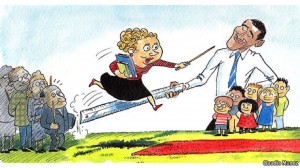I PROGRESSI DELLA VALUTAZIONE DEGLI INSEGNANTI NEGLI USA E LA SPERIMENTAZIONE DI NUOVI METODI IN QUESTO CAMPO
Editoriale pubblicato su The Economist, il 6 gennaio 2011. In argomento leggi anche l’articolo di Andrea Ichino, pubblicato su il Sole 24 ore, il 12 gennaio 2011
At last, America may change the way it trains, recruits and rewards teachers
BUDGET, curriculum, class size—none has a greater effect on a student than his or her teacher. Given this, politicians might be expected to do all in their power to ensure that America’s teachers are good ones. For decades, they have done the opposite. The trouble begins long before a teacher enters the classroom. In Singapore, which recently came second in an international ranking of 15-year-olds’ skill in maths (America was 31st), the teachertraining programme accepts only students in the top 30% of their academic cohort. In America, most teachers were mediocre students. Only 23% of new teachers were in the top third of college graduates.
Union rules make it extremely hard to fire teachers who turn out to be bad at their jobs. Younger teachers are usually the first to be let go, even though seniority does not necessarily ensure quality. In 2009 Indiana and Florida fired young staff who had been nominated for “teacher of the year”.
But the debate over bad teachers ignores an equally big problem: there has been little effort to identify good ones, let alone reward them. A survey by the New Teacher Project, a nonprofit organisation, found that school districts labelled more than 99% of their teachers “satisfactory”.
However America is slowly changing its way of recruiting, training and rewarding teachers. Last year 12% of seniors at Ivy League colleges applied to Teach for America, which sends graduates to teach at tough schools for two years. The New Teacher Project has a prestigious fellows programme that recruits and certifies new teachers. The Academy of Urban School Leadership in Chicago trains teachers in a programme modelled after a medical residency—part traditional coursework, part training in a classroom. Such models may become more common; in November the National Council for Accreditation of Teacher Education recommended that residency-style programmes become the norm. Eight states have already Improving teachers agreed to implement its suggestions.
Most difficult, however, is finding ways to evaluate teachers, rewarding the good and dismissing the bad. In 2009 Arne Duncan, Barack Obama’s education secretary, outlined his reforms in a speech to the National Education Association (NEA), America’s biggest union.
“When inflexible seniority and rigid tenure rules that we designed put adults ahead of children,” Mr Duncan insisted, “then we are not only putting kids at risk, we’re also putting the entire education system at risk.” Some members of the audience booed. Mr Duncan’s guidelines for Race to the Top, a $4.3 billion programme paid for with stimulus money, include rewards for states that evaluate teachers in new ways. As a result, some states have removed their ban on using test scores to judge teachers. Others have gone much further. Tennessee, which won a grant, now requires districts to create new evaluation systems, with at least half of the score based on students’ progress. In Colorado, Delaware and Rhode Island, teachers rated “ineffective” for two consecutive years can be sacked.
The reforms have rankled with the NEA, as expected. The American Federation of Teachers (AFT), the second-largest teachers union, has a more complex stance. “Conflict has been the status quo for all my years in education,” says Randi Weingarten, the AFT’s president. She insists that unions should spur change. She praised bold reforms in Colorado, while that state’s NEA opposed them. But she clashed ferociously with Michelle Rhee, then the schools chief in Washington, DC. Ms Rhee’s new group, StudentsFirst, aims to be a counterweight to the unions.
Despite this brewing battle, America has at least one model of peaceful change. In 2009 Hillsborough County, Florida, won a grant from the Gates Foundation to transform its way of evaluating, developing and rewarding teachers. Notably, the district is working productively with its union. “I want to be fair to my employees,” explains Mary Ellen Elia, Hillsborough’s superintendent. “I also want to have only good teachers in my classrooms.” Teachers will be judged on their pupils’ progress, as well as evaluations by a principal and by a peer. Teachers with high ratings, based on three years of data, will have higher salaries. Bad teachers will see their salaries shrink. A struggling teacher will receive further training. If he continues to be ineffective, Mrs Elia will act to remove him.
The Gates Foundation hopes that further research will see such reforms replicated elsewhere. In seven districts, including Hillsborough, the foundation is testing methods for measuring a good teacher. Researchers are trying to answer teachers’ questions about whether such a feat is possible—are observations biased, for example, and can one isolate a teacher’s effect on a students’ progress?
The biggest change may come with the reauthorisation of the Elementary and Secondary Education (ESEA) bill. Its most recent incarnation, No Child Left Behind, required that all teachers be “highly qualified”, state-certified and competent in the subjects they teach. Messrs Duncan and Obama want to value effective teachers, not “qualified” ones. Under their plan for ESEA, states would have to improve their evaluation systems. Grants would go to states and districts that develop innovative ways to train or reward good teachers.
A fight over these plans is inevitable. However John Kline, the new Republican chairman of the House education committee, has praised Mr Duncan’s reforms. Mr Obama and the Republicans were remarkably productive in December. If the co-operation continues, they just might transform American education.

